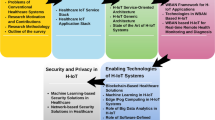Abstract
Tele-Medical data communication via general purpose networking protocols and techniques are major set-back under low line channels and adequate resources such as bandwidth, frequency, power spectrum for transmission and impacts the Quality of Data (QoD) on transmission line. In this paper, a heterogeneous multi-input multi-out (MIMO) based dynamic user clustering technique is proposed and the protocol is termed as TelMED. The proposed technique introduces machine learning terminology on networking nodes for dynamic user grouping and classification resulting in the formation of clusters with reflective similarity indexing ratio. The dynamic clustered users of TelMED protocol are allocated with resources for the transmission of Multi-Objective Optimized Medical datasets resulting in creation of virtual telemedicine networking environment with a given typical network space. The technique is designed on clustered user grouping size of maximum 32 users for reliable results over a fixed networking space and optimized resources for low line transmission channels of rural or remote networks. The resulting technique proves an efficiency of 92.3% over dynamic MIMO user grouping.












Similar content being viewed by others
References
Ahmed, S. S. T., Sandhya, M., & Shankar, S. (2019). ICT’s role in building and understanding indian telemedicine environment: A study. In S. Fong, S. Akashe & P. Mahalle (Eds.), Information and communication technology for competitive strategies, Lecture Notes in Networks and Systems (vol 40). Singapore: Springer.
Choi, Y. B., et al. (2006). Telemedicine in the USA: standardization through information management and technical applications. IEEE Communications Magazine,44(4), 41–48.
Loane, M., & Wootton, R. (2002). A review of guidelines and standards for telemedicine. Journal of telemedicine and telecare,8(2), 63–71.
Wood, C. L., et al. (2016). Use of telemedicine to improve adherence to American Diabetes Association standards in pediatric type 1 diabetes. Diabetes Technol Ther,18(1), 7–14.
Kiran Kumari, P., & Thouheed Ahmed, S. (2014) Digital telemammography services for rural India, software components and design protocol. In 2014 International conference on advances in electronics, computers and communications (ICAECC). IEEE.
Ahmed, S. S. T., Thanuja, K., Guptha, N. S., & Narasimha, S. (2016). Telemedicine approach for remote patient monitoring system using smart phones with an economical hardware kit. In International conference on computing technologies and intelligent data engineering (ICCTIDE) (pp. 1–4). IEEE.
Cho, G.-Y., Lee, S.-J., & Lee, T.-R. (2015). An optimized compression algorithm for real-time ECG data transmission in wireless network of medical information systems. Journal of Medical Systems,39(1), 161.
Singh, A. K., Dave, M., & Mohan, A. (2015). Multilevel encrypted text watermarking on medical images using spread-spectrum in DWT domain. Wireless Personal Communications,83(3), 2133–2150.
Rahmani, A. M,. et al. (2015). Smart e-health gateway: Bringing intelligence to internet-of-things based ubiquitous healthcare systems. In 2015 12th annual IEEE consumer communications and networking conference (CCNC). IEEE.
Ali Hassan, S., et al. (2018). Energy efficiency comparison between data rate control and transmission power control algorithms for wireless body sensor networks. International Journal of Distributed Sensor Networks,14(1), 1550147717750030.
Mohamed, E., et al. (2018). Secure medical data transmission model for IoT-based healthcare systems. IEEE Access,6, 20596–20608.
Yaakob, N., & Khalil, I. (2016). A novel congestion avoidance technique for simultaneous real-time medical data transmission. IEEE Journal of Biomedical and Health Informatics,20(2), 669–681.
Surendar, A., & Kavitha, M. (2017). Secure patient data transmission in sensor networks. Journal of Pharmaceutical Sciences and Research,9(2), 230.
Pantazoglou, E., et al. (2017) Standardizing the transmission of genomic-related medical data for the optimization of diagnostics and research in the field of oncological diseases. European Journal of Biomedical Informatics, 13(1).
Tao, L. (2015). Telemedicine transmission system design research based on session initiation protocol. Journal of Software Engineering,9(2), 298–307.
Shen, Y., et al. (2016) High frequency sensors for robust transmission in telemedicine system. In 2016 IEEE 14th international conference on industrial informatics (INDIN). IEEE.
Kawakami, S., et al. (2016). Time to reperfusion in ST-segment elevation myocardial infarction patients with vs. without pre-hospital mobile telemedicine 12-lead electrocardiogram transmission. Circulation Journal,80(7), 1624–1633.
Wang, G., et al. (2017). Transmission delay performance in telemedicine: A case study. In 2017 39th annual international conference of the IEEE engineering in medicine and biology society (EMBC). IEEE.
PWS Retrieved April 6, from https://www.oreilly.com/library/view/radio-protocols-for/9781118188569/chapter10.html.
Ahmed, S. T., & Sandhya, M. (2019). Real-time biomedical recursive images detection algorithm for indian telemedicine environment. In P. Mallick, V. Balas, A. Bhoi & A. Zobaa (Eds.), Cognitive informatics and soft computing, Advances in intelligent systems and computing (vol 768). Singapore: Springer.
Ahmed, S. T., Sandhya, M., & Sankar, S. (2019). A Dynamic MooM Dataset Processing under TelMED protocol design for QoS improvisation of telemedicine environment. Journal of Medical Systems. https://doi.org/10.1007/s10916-019-1392-4.
Ahmed, S. T., Sandhya, M., & Sankar, S. (2019). An optimized RTSRV machine learning algorithm for biomedical signal transmission and regeneration for telemedicine environment. Procedia Computer Science, 152, 140–149.
Author information
Authors and Affiliations
Corresponding author
Additional information
Publisher's Note
Springer Nature remains neutral with regard to jurisdictional claims in published maps and institutional affiliations.
Rights and permissions
About this article
Cite this article
Ahmed, S.T., Sandhya, M. & Sankar, S. TelMED: Dynamic User Clustering Resource Allocation Technique for MooM Datasets Under Optimizing Telemedicine Network. Wireless Pers Commun 112, 1061–1077 (2020). https://doi.org/10.1007/s11277-020-07091-x
Published:
Issue Date:
DOI: https://doi.org/10.1007/s11277-020-07091-x




